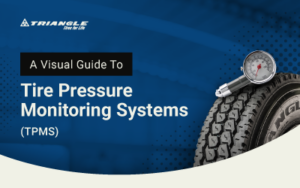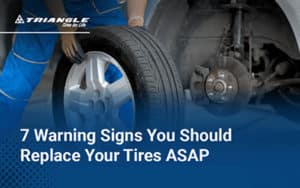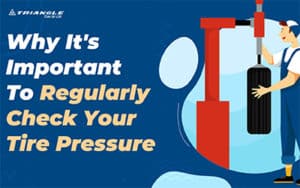Did you know that tires do not support a vehicle’s entire weight? That is, the air within the tires supports the car, which is possible due to tire pressure. Whether it’s passenger cars or heavy trucks, drivers of all types of vehicles should know the concept of tire pressure.
If you want to know more, this infographic will illustrate the basic concepts of tire pressure. We’ll also answer frequently asked questions about tire pressure.

What is Tire Pressure?
Simply put, tire pressure is the amount of air inside tires. A vehicle’s tire pressure measurement can be in three units: pound per square inch (PSI), kilopascals (kPa), and barometric pressure—otherwise known as BAR. Depending on your vehicle, you may need to convert one of these units of measurement to another.
In the Philippines, tire PSI (Pounds per Square Inch) is commonly used to measure its pressure. Recommended pressures vary with the size of the car and its tires, small cars are usually 30 psi, medium cars are 36 psi, and large cars are 42 psi. Warm tires may exceed cold tire pressures by 4-6 PSI.
Kilopascals is a metric unit equaling 1,000 pascals. Since kilopascals are relatively small units used to measure low-pressure environments, it is the most used measurement for tire pressure. Most countries that use the metric system, especially European countries, use kPA to measure tire pressure.
BAR is often used in weather forecasting to measure atmospheric pressure. Much like kPa, areas that use the metric system also use BAR as an alternative unit of measurement.
The importance of being knowledgeable about tire pressure cannot be overemphasized. Tires that meet the ideal air pressure are more durable and contribute to vehicle safety, whereas low tire pressures tend to provide less responsive handling and steering, affecting braking distances.
Unreliable car safety mechanisms can be significantly more dangerous when a sudden evasive maneuver or complete stop is necessary to avoid a collision. Correct tire pressure maximizes car safety, tire lifespan, driving comfort, and gas mileage.
What is the Right Tire Pressure for Your Car or Truck?
The correct tire pressure will vary depending on vehicle size. The maximum tire pressure for passenger cars and light trucks is 30–35 PSI. In contrast, bigger and heavier trucks’ tire pressure typically reaches up to .
However, specialized vehicles like class 8 trucks may require higher tire pressure levels for optimum performance. Tire pressure for class 8 trucks can be as high as 105 PSI, which is the maximum permissible but not necessarily the recommended tire pressure level for these vehicle types.
If you want to know the correct tire pressure, you can check the driver’s side door, and there will be a sticker stating the size of your tires and their ideal PSI.
Another way to get information on your tires’ PSI is to check the owner’s manual. Much like the PSI sticker, it indicates all the necessary information about your tire pressure. Alternatively, you can get more information online from trusted sources.
How to Check Tire Pressure Levels
Regularly checking tire pressure levels is necessary to ensure safety and car efficiency. Here is a step-by-step guide, safety precautions, and best practices when checking tire pressure levels.
- Begin by determining the recommended PSI for your car tires. Again, you can quickly check your vehicle’s recommended PSI levels by referring to the manufacturer’s manual, the PSI sticker found on the driver’s side door, and the official website of your car manufacturer or reliable online sources. Then prepare the necessary tools like a tire pressure air gauge.
- Next, remove the valve cap from your tire and press the tire pressure gauge firmly on the valve stem.
- If the reading is below the recommended tire pressure of your vehicle, inflate your tires by pushing on the air compressor nozzle for about 30 seconds to 1 minute. The inflation time will depend on the initial tire pressure reading.
- If the reading is above the recommended tire pressure of your vehicle, release air in small increments by pressing on the central pin of the tire valve stem.
- After the inflation or deflation, recheck the tire pressure to ensure you have the correct PSI.
- Once the tire has achieved the ideal PSI, repeat the same process for the remaining three tires.
When (and How Often) Should You Check Tire Pressure Levels?
Some car owners overlook the importance of proper tire pressure levels. But, having the correct tire pressure is crucial in extending the durability of your vehicle and tires, providing a quicker steer response, and saving fuel. Car experts recommend checking your tire pressure levels at least once a month to ensure proper tire inflation and car safety.
A regular check-up is essential due to environmental factors, such as how fluctuating ambient temperatures affect tire pressure. Tire pressure may increase or decrease in ambient temperatures by 1 PSI.
While this might seem like an unremarkable drop, sudden increases and decreases in tire pressure can significantly speed up the degradation of your tires.
It’s best to refer to the manufacturer’s manual or consult them directly to determine your vehicle’s ideal tire pressure levels. And since tire pressure drops at least 1 PSI monthly, checking all four tires and your spares during significant temperature swings is necessary.
Investing in a Tire Pressure Monitor System (TPMS) can make the checking process easier. However, it would be best if you didn’t solely rely on technology. Instead, it would help if you learned how to identify tire pressure problems or had consultations with a tire expert.
Tire Pressure FAQs
Do the front and rear tires require different air pressure?
It depends on your preference regarding load and handling. One-ton trucks and commuter cars primarily carry items and passengers, so some people might choose to increase their rear tire pressure for the vehicle to accommodate more weight.
Then there are those who want their vehicles to be more stable. As such, they tend to increase the rear tire pressure. However, decreasing tire pressures on small trucks like pickups are not ideal. Lowering smaller trucks’ back tire pressure will not help their stability or load-carrying capacity.
Generally, you should follow the same variance the vehicle’s manufacturer recommends.
Should I fill my tires up to the maximum tire pressure?
Filling your tires with maximum tire pressure is not recommended. Inflating your tires to the maximum PSI can lead to a change in vehicle handling and a decrease in tire durability. Overinflating your tires can compromise the brake threshold, and your rubber rounds can succumb to wear and tear faster.
Can I solely rely on the TPMS on newer cars?
The TPMS installed in most brand-new cars warns you if one or more of your tires is significantly under-deflated. Specifically, your TPMS will give a low-pressure warning after your tire pressure drops 25% below the vehicle manufacturer’s recommended levels. That means a slight drop in tire pressure, which can pretty much reduce fuel economy and tire performance, will not trigger a warning.
Therefore, even if your vehicle has a TPMS, you should still perform a monthly check using a tire pressure air gauge to ensure optimal performance.
What happens if a tire is over or under the recommended pressure?
Inflating your tires beyond the recommended tire pressure will alter their shape, leading to decreased traction and increased wear and tear at the center of the tire.
On the other hand, under-inflated tires are the leading cause of tire failure. If the tire pressure is too low, part of the tire’s surface area may touch the road, causing increased friction. This increased friction can lead to overheating, causing tread separation, tire blowouts, or premature wear.
What are common signs a tire is under-inflated?
One of the telltale signs your tire is under-inflated is when the brakes take longer to respond. Since an under-inflated tire creates more friction, you might find it harder to make the vehicle come to a complete stop.
Aside from your car not handling well, other signs you should look out for are cracks in your tire and the constant shaking of the vehicle during driving.
Prioritizing Safety and Performance
Tire pressure is one of the most critical factors regarding car safety. Slight miscalculations can cause different aspects of your vehicle to malfunction, resulting in road accidents or injuries. It’s essential to conduct regular check-ups and maintain proper tire pressure to ensure your car drives and performs smoothly.
If you’re looking for quality tires, Triangle Tires can help. From passenger cars and light trucks to heavy equipment vehicles, we have a wide array of tires ready for delivery at an affordable price. Browse our tire catalog or contact us today for your tire needs.


